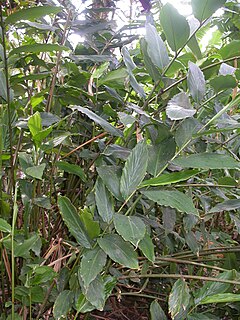
Parochetus communis, known in English as shamrock pea or blue oxalis, is a species of legume, and the only species in the genus Parochetus and in the subtribe Parochetinae. It is a low-growing plant with blue papilionaceous flowers and clover-like leaves. It is found in the mountains of Asia and tropical Africa, and has been introduced to New Zealand.
Erythrina schliebenii is a species of legume in the family Fabaceae. It is found only in Tanzania. The species is named for German collector and botanist Hans-Joachim Schlieben.

Tapinanthus is a genus of mistletoe in the family Loranthaceae, endemic to Africa. The name of the genus is derived from the Greek tapeinos meaning "low" or "humble" and anthos meaning flower.

Aframomum zambesiacum is a species in the ginger family, Zingiberaceae. Its common name is nangawo. It is native to Kimalila, part of the southern highlands in Tanzania. A. zambesiacum grows in upland and secondary forests, often near water, between altitudes of 1,450–2,050 m (4,760–6,730 ft).

Agelanthus is a genus of Afrotropical plants in family Loranthaceae. They grow in trees, including Acacia and Combretum species, as hemiparasitic shrubs of varying sizes. The host plant is penetrated by a single haustorium, and the stems typically have swollen, flower-producing nodes. The flowers are often closely clustered (fascicled) with the five petals (pentamerous) fused into a tube (gamopetalous). The flower may have a swollen base and the tubes open along unilateral, V-shaped splits. The filaments remain spirally rolled inward when the flowers open, while the styles are inconspicuous, slender filaments that are somewhat thickened in the middle. Berries range from pink to orange and red in colour, and are around 1 cm in diameter.

The blue-leaved mistletoe is a species of perennial, parasitic plant in the family Loranthaceae, which is native to the southeastern Afrotropics.
Agelanthus rondensis is a species of hemiparasitic plant in the family Loranthaceae. It is endemic to Tanzania.
Agelanthus kayseri is a species of hemiparasitic plant in the family Loranthaceae, which is native to Kenya, Tanzania and Somalia.
Agelanthus keilii is a species of hemiparasitic plant in the family Loranthaceae, which is native to Rwanda, Tanzania and Burundi.
Agelanthus igneus is a species of hemiparasitic plant in the family Loranthaceae, which is native to Mozambique and Tanzania.
Agelanthus microphyllus is a species of hemiparasitic plant in the family Loranthaceae, which is native to Ethiopia, Kenya and Tanzania.
Agelanthus uhehensis is a species of hemiparasitic plant in the family Loranthaceae, which is native to Tanzania.
Agelanthus validus is a species of hemiparasitic plant in the family Loranthaceae, which is found in the Usambara Mountains, Tanzania
Agelanthus longipes is a species of hemiparasitic plant in the family Loranthaceae, which is found in the Tanzania, Mozambique and Kenya.
Agelanthus pennatulus is a species of hemiparasitic plant in the family Loranthaceae, which is found in Tanzania, and Kenya.
Agelanthus myrsinifolius is a species of hemiparasitic plant in the family Loranthaceae, which is native to Rwanda, Zaire and Burundi.
Agelanthus nyasicus is a species of hemiparasitic plant in the family Loranthaceae, which is native to Botswana, Malawi, Mozambique, Tanzania, Zambia, Zaïre and Zimbabwe.

Agelanthus natalitius is a species of hemiparasitic plant in the family Loranthaceae, which is native to the Cape Provinces, KwaZulu-Natal, Mozambique, the Northern Provinces, South Africa, Eswatini and Botswana.
Vanwykia is a genus of flowering plants belonging to the family Loranthaceae.






